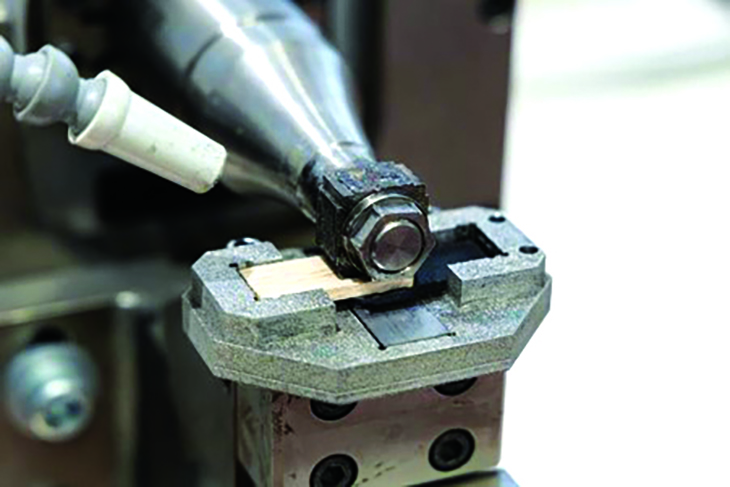Adhesive-free joining of wood, metal

Researchers at TU Graz in Austria have made significant strides in developing an adhesive-free process for joining wood to metal and polymer composites. This advancement utilises 3D printing and ultra-sonic joining techniques, resulting in exceptionally strong bonds that could transform manufacturing in industries such as aerospace, automotive and furniture.
The research team from the Institute of Materials Science, Joining and Forming has tested two innovative methods: ‘AddJoining’ and ‘Ultrasonic Joining’. Both approaches create durable joints while emphasising environmental sustainability.
“Our motivation is environmental protection,” explains Sergio Amancio, the research leader. He highlights the potential for using renewable materials like wood to replace components traditionally made from energy-intensive or hard-to-recycle materials.
The AddJoining technique involves directly 3D printing a polymer composite onto a wooden surface. This process allows the printed material to penetrate the wood’s pores, where a chemical reaction occurs akin to that of traditional adhesives. The results from mechanical load tests indicate these connections are remarkably robust.
Durable connections
Gean Marcatto, a post-doctoral researcher, notes that after joint failure, they found polymer embedded in the wood and broken wood fibres in the polymer, suggesting the fracture occurred within the materials rather than at the joint interface.
Although the initial tests utilised untreated wood surfaces, the potential for even stronger joints exists. Introducing micro- or nano-structures into the wood through laser texturing or etching could enhance bonding surfaces and improve joint durability.
However, Amancio emphasizes the team’s commitment to simplicity: “We aimed to work with as few steps as possible and, above all, without chemicals.”
This focus on minimal processing is particularly advantageous for complex 3D geometries, allowing components to be printed in any desired shape directly onto the wood.
Vibration effect
The Ultrasonic Joining method employs high-frequency vibrations applied to the wooden component via a sonotrode. This vibration generates friction at the interface with the polymer or polymer composite, creating heat that melts the surface of the polymer.
The molten material infiltrates the wood’s natural pores, forming a stable joint through mechanical interlocking and adhesive forces. Awais Awan, who dedicated his doctoral research to this technique, emphasizes its suitability for large components and 2D structures, enabling precise localised spot joints.
Both joining methods have undergone rigorous mechanical testing, showing impressive results. As with AddJoining, the strength of ultra-sonic joints can also be enhanced through surface pre-treatment, such as laser texturing.
The research from TU Graz not only demonstrates a promising alternative to traditional joining methods but also aligns with a broader movement towards sustainable manufacturing practices.
Comments

- ‘Red gazelle’ makes window installation easy
- Felder’s solutions for window and door production
- Versatile sliding-folding systems from Hafele
- Door line automation from Woodtech Consultants
- Accutec solutions for uPVC windows
- Jowat’s VOC-free primer for window profile wrapping
- Flexible solutions for doors, windows from SCM
- Tostem introduces Giesta steel doors; calls for dealers
- Folder system by Salice optimises cabinet space
- Turakhia has top-quality veneers for doors
- Mirka has solutions for difficult sanding of doors
- When Lamello’s Cabineo became a game changer
- Digital lacquer embossing for flooring from Hymmen
- Weber sanders help achieve luxury surfaces
- Rehau has designs on growing edge band market
- Samet ties up with Greenply to tap Indian hardware market
- IMA Schelling sets up base in India
- Hettich earns BIS nod for hinges, runners
- Biesse India now a Multi-Material Expert
- The importance of selecting the correct tools
- Indian cabinet maker shines at Lyon WorldSkills
- ‘Collaboration holds the key to success’
- Fibreboard recycling becomes a reality
- MumbaiWood now a recognised destination
- Knock on wood: A bouquet of training courses!
- Ligna 2025: ‘Thinking in circles’
- CIFF-Shanghai focuses on furniture design
- Felder hosts in-house show, Technology Days
- Interzum Forum Italy makes impressive debut
- Koelnmesse ties up for 3-in-1 Jakarta fair
- WOFX: a global hub for innovation and growth
- Events Calendar: industry fairs you must visit
- 3D is printing sustainable housing solutions
- Hard or soft? Researchers discover new wood type
- Master, apprentices take AHEC’s cherry challenge
- ‘Zero-to-launch’ modularity transforming hospitality
- ICA’s Urban Matter is about satin-finish metal effect
- MTC’s ‘Woven timbers’ create waves
- Impact of material in interior design
- Underestimated danger: Sharp edges
- Playing safe on clothing storage units
- ‘Green’, 3D-printed panel floors it!
- Adhesive-free joining of wood, metal
- Energy-efficient manufacturing of fibre-based products
- Rice bran wax: a sustainable alternative
- Dual-side hand sanding block has unique features
- Bio-based products for sustainable development
- ‘Wood Vaulting’ may enhance CO2 sequestration
- Protecting forests through advanced AI
- Forest certification benefits wildlife too!
- Elizure, the Rolls Royce of laminates!
- Rehau unveils new Rauvisio Riviera collection
- Hawa Concepta III: upgrade to seamless functional doors
- Hafele’s RE-Twist locks in on security
- Optimus machines feature tomorrow’s technology today
- Merino unveils cutting-edge offerings
- Ornare launches new premium laminates
- New nesting models from SCM
- Advanced moulder, membrane press from Woodtech
- Greenlam Laminates unveils exclusive display centre in Pune
- EUDR implementation dates may be deferred
- Herman Miller introduces bamboo upholstery
- Altendorf named ‘Brand of the Century’
- Catas to verify its test reports
- Combilift wins two prestigious awards
- Holz-Her management transition
- Replica of the Oval Office opens
- Ozone Blu sets up experience centre
- SCM opens new subsidiary in Slovenia
- VDMA faces business stagnation
- RentoMojo reports strong growth in FY24
- Century Plyboards on expansion mode
- Subhra named DG of FSC
- Meta to assist Skill India Mission
- Sugatsune opens Bengaluru experience centre
- Dieffenbacher acquires Pagnoni
- Pepperfry partners with Infra.Market
- Hafele opens light store in Chandigarh









































